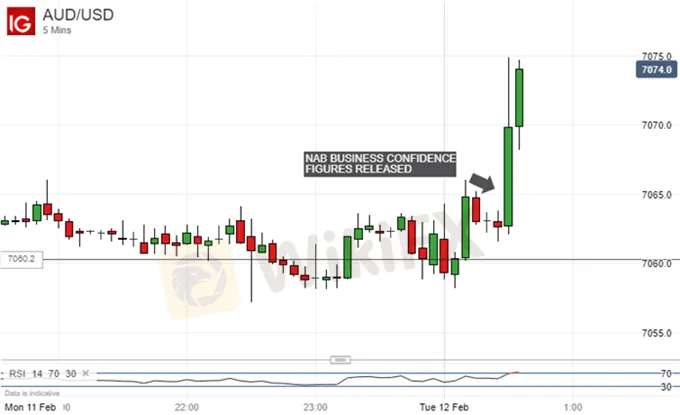简体中文
繁體中文
English
Pусский
日本語
ภาษาไทย
Tiếng Việt
Bahasa Indonesia
Español
हिन्दी
Filippiiniläinen
Français
Deutsch
Português
Türkçe
한국어
العربية
Battered AUD Takes Comfort From Modest NAB Confidence Beat
Abstract:The poor old Australian Dollar will clearly take any good news it can get at this point, with a very modest revival for NABs business
First-quarter technical and fundamental forecasts from the DailyFX analysts are out now.
The Australian Dollar made some quick gains Tuesday following the release of a business survey which was slightly less downbeat than its two predecessors.
The monthly snapshot from National Australia Bank revealed a business confidence indicator of 4 for January. This is pretty miserable, historically speaking, certainly well below the long-term average of 6. It was at least better than the threes seen in the two previous months.
Perceptions of business conditions also perked up though. That balance came in at 7, much better than Decembers woeful 2 (now revised up to 3).
NAB also changed its view on the likely interest rate path ahead. It now thinks the Official Cash Rate will be held at its 1.50% record low this year and next. Before it had looked for an increase in late 2020.
AUD/USD‘s vigor after this modest data was quite surprising at face value but, given this series’ former trajectory, it is likely that the market was positioned for a weaker figure.

The Aussie was pummeled hard last week by the Reserve Bank of Australias admission that rates could yet fall further – an ostensibly major turnaround from its previous conviction that rises were more likely. The currency then took a further battering when the central bank revised down its forecasts for both growth and inflation.
Given an abject lack of interest-rate support it is very hard to see a medium-term prognosis for the Aussie beyond continued weakness, perhaps to a quite marked degree. However, the currency may have been judged to have suffered enough for now, as Tuesday‘s response to really quite muted ’good news shows.
For the moment AUD/USD seems to be holding just above the dominant downtrend channel which marked trade from most of last year.

However, the bout of strength against the US Dollar which marked the start of 2019 has now been comprehensively crushed and a slide back into that channel looks overwhelmingly likely.
Australian home loans fell by 6.1% on the month in December, much worse than the 2% fall expected, but this series has been weakening for some time and had no noticeable currency impact.
Disclaimer:
The views in this article only represent the author's personal views, and do not constitute investment advice on this platform. This platform does not guarantee the accuracy, completeness and timeliness of the information in the article, and will not be liable for any loss caused by the use of or reliance on the information in the article.
Read more

KVB Market Analysis | 28 August: Yen Strengthens on BoJ Rate Hike Hints; USD/JPY Faces Uncertainty
The Japanese Yen rose 0.7% against the US Dollar after BoJ Governor Kazuo Ueda hinted at potential rate hikes. This coincided with a recovery in Asian markets, aided by stronger Chinese stocks. With the July FOMC minutes already pointing to a September rate cut, the US Dollar might edge higher into the weekend.

KVB Market Analysis | 27 August: AUD/USD Holds Below Seven-Month High Amid Divergent Central Bank Policies
The Australian Dollar (AUD) traded sideways against the US Dollar (USD) on Tuesday, staying just below the seven-month high of 0.6798 reached on Monday. The downside for the AUD/USD pair is expected to be limited due to differing policy outlooks between the Reserve Bank of Australia (RBA) and the US Federal Reserve. The RBA Minutes indicated that a rate cut is unlikely soon, and Governor Michele Bullock affirmed the central bank's readiness to raise rates again if necessary to combat inflation.

KVB Market Analysis | 23 August: JPY Gains Ground Against USD as BoJ Signals Possible Rate Hike
JPY strengthened against the USD, pushing USD/JPY near 145.00, driven by strong inflation data and BoJ rate hike expectations. Japan's strong Q2 GDP growth added support. However, USD gains may be limited by expectations of a Fed rate cut in September.

KVB Market Analysis | 22 August: Gold Stays Strong Above $2,500 as Fed Rate Cut Hints Loom
Gold prices remain above $2,500, near record highs, as investors await the Federal Open Market Committee minutes for confirmation of a potential Fed rate cut in September. The Fed's dovish shift, prioritizing employment over inflation, has weakened the US Dollar, boosting gold. A recent revision showing the US created 818,000 fewer jobs than initially reported also strengthens the case for a rate cut.
WikiFX Broker
Latest News
Why Even the Highly Educated Fall Victim to Investment Scams?
Warning Against Globalmarketsbull & Cryptclubmarket
Axi Bids AUD 52M to Acquire Low-Cost Broker SelfWealth, Outbidding Competitor Bell Financial
Crypto Influencer's Body Found Months After Kidnapping
Currency Calculator



